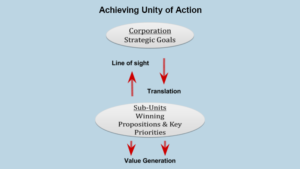“It’s not enough to do your best. You must know what to do, then do your best.”
– W. Edwards Deming
We are all familiar with the seductive distractions of the here and now that commandeer our attention, control our thinking, and scatter our exertions.
The average American spends 3.3 hours a day on a mobile phone, 10 times the duration in 2008. Total usage, including all IT devices, adds up to nearly 6 hours, which rivals sleep time.
The rapid flow of information demands our immediate reaction. We harbor a fantasy that when we finish these “urgent” tasks, we will have the time to tackle the important ones. But our “to do” lists never end as the additions outrun our accomplishments. Our lives are becoming like Sisyphus who was condemned for eternity to push a boulder up a hill, only to watch it roll down again.
The experts say that we fool ourselves when we think we are multitasking. Only about 2.5% of the population can actually concentrate effectively on more than one thing at a time. The rest of us are “task switching” – moving rapidly between tasks – dissipating rather than concentrating our cognitive energy. Neuroscientists Kubu and Machado report that the more we switch tasks the less we are able to accomplish because we slowly lose our ability to focus deeply enough to learn.
This is not just a problem. It’s a crisis. Immediacy has overtaken purpose. Yet it is purpose that gives our lives meaning. We need to make a major adjustment to the way we focus our energy.
The distraction epidemic spans both the personal and organizational domains. 54% of executives feel that being consumed by day-to-day activities is the main barrier to organizational success according to a recent survey. And 45% of these executives believe that this lack of strategic thinking is also the biggest obstacle to their individual leadership potential.
To concentrate effectively, we have to tune out the rest of the world. As an example, Kubu and Machado cite the skill of a surgeon: “The proficiency of surgery is the ability to single-mindedly focus on a single patient and complete a series of tasks, all in pursuit of a given outcome that may take many hours to finish.”
Leadership experts stress that, just like a surgeon’s intense focus, the single-minded commitment to a common purpose is an essential factor for organizational success. This is the role of strategy, whose main job is to define a firm’s purpose in terms that everyone can relate to and act upon.
The starting point is to develop a shared understanding of what strategy is and what it must deliver for an organization. Strategy is about making choices on how an organization will concentrate its scarce resources in order to achieve competitive advantage. Its aim is to create an intense focus on the right things.
Strategic choice-making requires answers to three fundamental questions:
– Where will we compete and what is our aim?
– How will we win the competition for value creation in our chosen arenas?
– What will be our key priorities for success?
To achieve unity of action, the sum of a company’s actions must cascade from these choices so that all of its constituent parts are acting in concert.
It is crucial to understand that in a competitive world strategy is about winning. The heart of a company’s strategy is its Winning Proposition – the unique difference in its offering that provides a compelling reason for customers to choose it over its competitors. Its Winning Proposition is the central animating idea – the rallying cry – that unifies an organization’s priorities, decisions and activities.
Google’s Winning Proposition for its search business provides a good example:
We organize the world’s information and make it universally accessible and useful.
Google’s key priorities are centered around three action verbs: organizing information, creating access and making the result useful. All its resources and the energies of its people are concentrated on providing and constantly improving those three interrelated outcomes.
How can organizations craft a shared framework for creating unity of action behind their strategic purpose?
The graphic below offers such a framework that I have found works well in practice.
Each sub-unit needs to develop a clear line of sight to the enterprise’s strategic goals (what the military calls “commander’s intent”) and translate these down into set of aligned priorities within each function, business unit and geography. By doing so, they relate all their efforts mindfully to the organization’s core purpose.
A parable about three workmen illustrates the point. A passer-by comes across a construction site, and asks each worker in turn, “What are you doing?” The first worker answers: “I am digging a hole.” The second worker says, “I’m laying bricks.” The third worker stands proudly erect and replies, “I’m building a cathedral.”
It is the role of leaders to remind their employees that they are dedicated to a cause larger than themselves, with the opportunity to make a difference to the outcome. The first worker is not simply digging a hole but creating strong foundations so that the cathedral will stand for a thousand years. The second worker is not simply laying bricks but creating a beautiful façade so that travelers will come from the ends of the earth to admire his handiwork.
The same principles should guide our personal lives. To quote Seneca, “Our plans miscarry because they have no aim. When a man does not know what harbor he is making for, no wind is the right wind.”
When Hans Vestberg was CEO of Ericsson, (he is now CEO of Verizon), he regularly gave a talk to Ericsson executives in seminars that Columbia Business School ran for the company. He explained a simple yet effective method for ensuring that his daily activities aligned with the organization’s strategic purpose. He kept two “to do” lists. On his left were his tasks for the day. On his right he kept his list of the company’s strategic priorities. Each morning he studied both lists. Then he identified the items on his daily list that most strongly supported the strategic priorities and tackled those first.
Hans’s practical example provides a powerful way for us all to mobilize the urgent in service of the important.








